Food Processing industry in India 2022
The food processing industry is one of the pillars of the global economy with a valuation of 2 trillion dollars now and expected to reach 4 trillion dollars by 2030.
India’s food ecosystem offers huge opportunities for investments in India. The stimulating growth in the food retail sector, favorable economic policies, and attractive fiscal incentives are the major catalysts for this sector in the country. The food processing industry in India is the Sunrise Industry.
What is Processed Food?
The United States Department of Agriculture (USDA), in their journal, has answered every such question, that any raw agricultural products that have been subjected to cleaning, washing, milling, chopping, cutting, heating, blanching, pasteurizing, cooking, freezing, canning, drying, mixing, packaging, dehydrating or other procedures that modify the food from its natural state are known as Processed Food.
Food processing includes many forms of processing foods, from grinding grain to make raw flour to home cooking to complex industrial methods used to make convenience foods.
Is Processed Food healthy?
There’s no doubt that every kitchen will have at least some processed foods which are used for preparing meals and can be time-savers. Processing by certain methods like pasteurization, cooking, and drying can destroy or inhibit the growth of harmful bacteria.
Additives such as emulsifiers help in preserving the texture of foods, such as preventing peanut butter from separating into solid and liquid parts. Similarly, through processing spoilage of food can be delayed and its sensory qualities, like flavor, texture, aroma, and appearance can be preserved.
But food processing also has drawbacks. Depending on the degree of processing, many nutrients other than proteins can be destroyed or removed. Proteins are one of the nutrients that are retained naturally throughout the processing.
Peeling the outer layers of fruits, vegetables, and whole grains may remove plant nutrients (phytochemicals) and fiber. Heating, frying, or drying foods can destroy certain vitamins and minerals, like vitamins B and C. Therefore, canned fruits possess less vitamin C than their fresh alternatives. Vitamin E is lost along with the oxidation of unsaturated fatty acids during heating. According to research, the levels of vitamin B12 are reduced by the process of fermentation. Another acid that results from fermentation is Lactic acid, which is a waste product. Although food manufacturers can add back some of the nutrients lost, it is impossible to recreate the food in its original form.
Similarly, the purpose of Pasteurization is to destroy all pathogens, reduce bacteria, inactivate enzymes, and extend the shelf life of the product. But it also reduces the Iodine content particularly in Milk by 20%, and vitamin C by around the range of 10% to 20%. In particular, pasteurization destroys enzymes that contribute to the immunity and digestion of the body.
Even in the baking process nutrient losses are around 5 – 15%. In this process Proteins gets coagulated, Sugars get caramelized, and change of minerals to their unusable and poisonous inorganic state are common.
Similarly, certain food additives used in the Food can represent some other major health safety concerns. Sugar as an additive endangers diabetes. Increased consumption of Sodium results in an increased risk for heart disease. Further, the food is processed mechanically, through extrusion, large mixing, grinding, chopping, and emulsifying equipment may introduce the risks of several contaminations. Such contaminants are leftover material from a previous operation, animal or human bodily fluids, microorganisms, and non-metallic and metallic fragments. Further processing of these contaminants will result in downstream equipment failure and the risk of ingestion by the consumer.
Forms of Food Processing
- Primary food processing: this form turns agricultural products, such as livestock, raw wheat kernels, or others, into something that can eventually be eaten. This is the ancient way to process any raw food by drying, threshing, winnowing, and milling grain, shelling nuts, and butchering animals for meat.
- Secondary food processing: this is the traditional form of the process of creating food from ingredients that are ready to be used as food. Such as Baking bread, fermenting fish, and making wine, beer, and other alcoholic products all come under Secondary Food processing.
- Tertiary food processing: This is the commercial way to process food with technological advancement. The foods produced in this way are commonly called processed food. These are ready-to-eat or heat-and-serve foods. Such a process may include additional ingredients such as flavors, nutrients, and preservatives. These processed food products are having demand in the global market due to their advantages such as easy cooking or immediate consumption, easy handling, preservation, and storage. Changing lifestyles, safety, and convenience are the major driving factors for the global processed food market.
The need for Food processing in the World
- Food Processing includes the purposes of toxin removal, preservation, easing marketing and distribution tasks, and increasing food consistency.
- Food Processing helps us with the availability of many seasonal food items throughout the year. It helps in the preservation of any perishable food safe to eat for a longer duration by de-activating spoilage and pathogenic micro-organisms
- Mass production of food by processing raw ingredients becomes more economical than any individual production.
- Processed food provides convenience to people from the hassle of cooking their meals.
Still to maintain the growth trajectory at the desired level the major challenge for the global processed food industry is health awareness, food contamination, and government regulations. Many health problems associated with preservatives and other additives are a major concern. However, with lots of innovations and upgraded technology, the food processing sector is attaining its maturity level.
The United States of America (USA), China, Germany, the Netherlands, and Japan are the major markets for processed foods. The range of products is huge. But out of that Meat, beverages, fruits and nuts, fish, and cereals only account for 43 percent of the total exports whereas USA, Netherlands, and Germany are the major exporters.
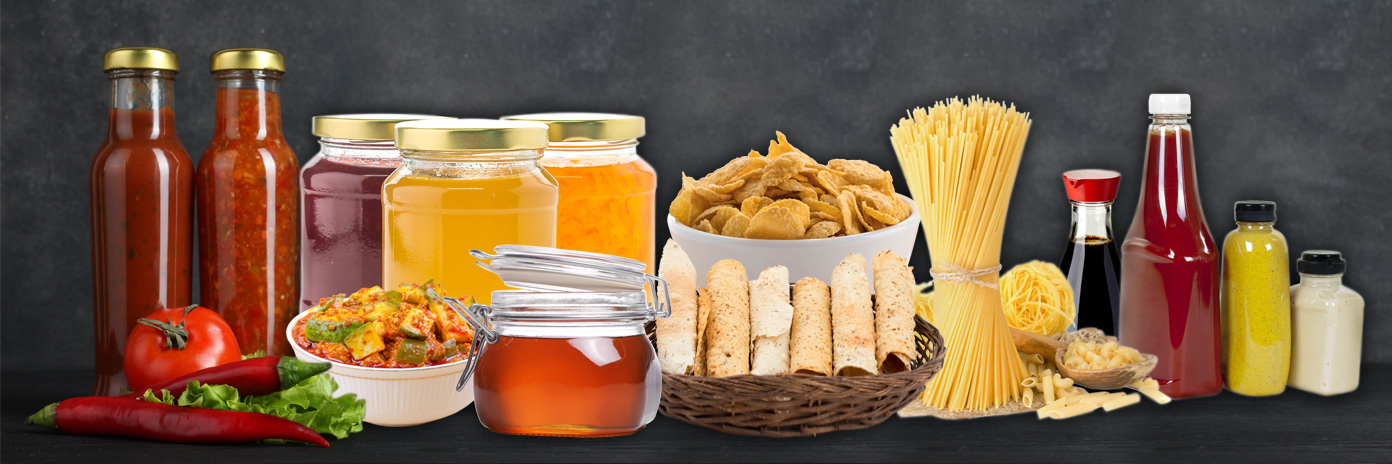
Global Market of Processed Food Products
- North America is the Largest Market for Processed Food. The Busy Lifestyle, Packaging Innovation, Expanded Lifestyle, and increased Snacking Trend play a major role in increasing demand for Processed Food.
- Europe has a high demand for High-Quality and Nutritious Food. Strict Government Regulations are the major challenge in this market. The European Processed Food Sector is by and large dominated by Basic Food Hygiene and Food Law requirements enumerated in Regulation (EC) No 178/2002 and Regulation (EC) No 825/2004.
- Processed Food Market is fast growing in Asia Pacific Region due to an increase in population and increased in consumer buying power. Cost competitiveness along with the availability of an abundant and wide range of Raw Materials are the Growth Drivers for the Processed Food Industry in India and China.
- In Latin America, Urbanization and Modernization are creating a demand for Processed Food. However, Regulations such as a Special 8% Tax on High-Calorie Food in Mexico from January 2014 have considerably affected the Processed Food Market. Also, the demand for Nutritious Processed Food in these regions is more prominently moving ahead in a positive direction.
- In the Middle East, limited agricultural production due to the adverse nature of the Climate, Terrain, and Water Scarcity has led to a significant increase in the Processed Food Market.
- United Nations estimated that the population of Africa will be doubled by 2050 which will be a market driver in this Region. Africa has the highest rate of population growth among major areas. Low Market Penetration is the major restraint in Africa.
Scope and significance of the Food processing industry in India
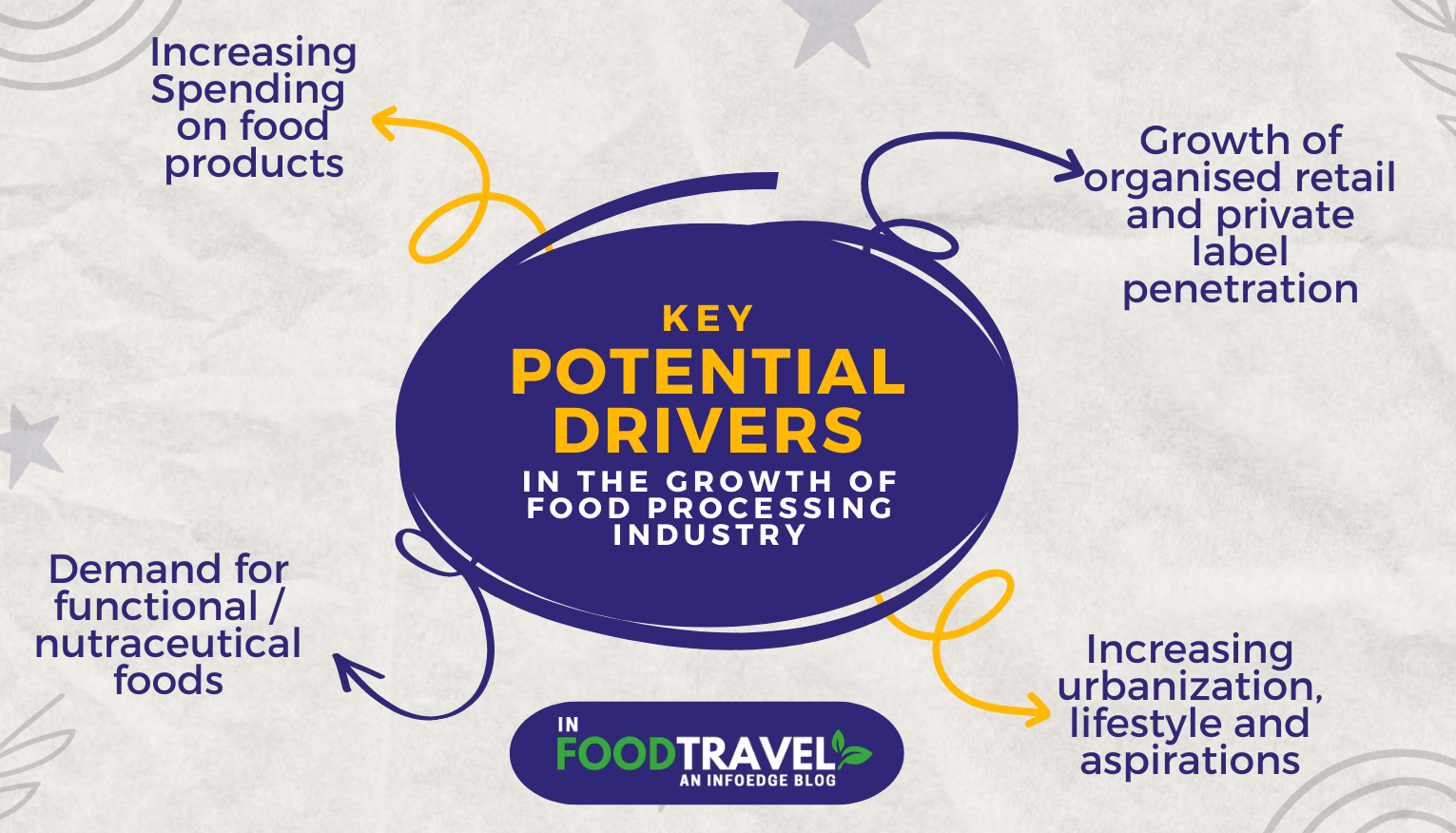
Scope of the Food Processing industry in India
The Indian food industry is poised for huge growth. In India, the food sector has emerged as a high-growth and high-profit sector due to its immense potential for value addition, particularly within the food processing industry.
The Indian food processing industry accounts for 32% of the country’s total food market, one of the largest industries in India, and is ranked 5th in terms of production, consumption, export, and expected growth.
The Indian food processing market alone is USD 263 billion (2019-20) and is expected to double to USD 535 billion by 2025. In the world market, India ranks fourteenth position as an exporter of food products to different countries.
Significance of the Food Processing industry in India
The Food Processing Industry (FPI) is of enormous significance. It provides vital linkages and synergies that promote the two pillars of the economy, i.e., agriculture and industry.
- Boosting farmers’ revenue: aids in increasing the revenue of the farmers due to the rise in demand for agricultural products and provides them a better marketplace with better scope for bargaining the price.
- Employment Generation: It provides direct and indirect employment opportunities in the economy.
- Reduce malnutrition: Processed foods have the option to be fortified with necessary vitamins and minerals to reduce the nutritional gap in the population.
- Reduce food wastage: According to estimates by the UN, around 40% of agricultural production is wasted. This loss can be shortened through proper sorting, grading, processing, and storing of food stocks at the factory level. Through processing, the shelf life of any seasonal raw food can be increased to maintain its availability throughout the year beyond seasonality. Through prolonged shelf-life, the nutritive quality of the food also can be maintained.
- Boosts Exports: processed foods can be produced and exported to meet the requirements of foreign buyers. This will also help the country in earning Foreign Exchange. Likely India is the biggest exporter of Basmati rice and few Spices to the world.
- Curbing Migration: food processing is a cost-sensitive but labor-intensive industry. Therefore, this sector has an enormous scope of generating huge localized employment and thus will help in curbing the issues like migration.
- Crop-diversification: food processing aids in creating an incentive for the farmer to cultivate profitably the diversified crop varieties.
- Food Varieties: enhances the quality and taste of food thereby bringing more choices to the food basket
- Enhances consumer choices: Today, food processing allows food to be transported across the world beyond the local market and vice versa.
The Indian food processing industry comprises 7 key sub-segments:
- Dairy,
- Meat & Poultry
- Fisheries & Marine
- Cereals, Grains & Oilseeds,
- Fruits & Vegetables,
- Beverages (non-alcoholic), and
- Packaged Food.
With India moving from a position of scarcity to surplus in terms of food production, the opportunities for increasing food processing levels are innumerable. In recent years, India’s food processing sector has been known for its high growth and high profits, thus, increasing its contribution to the world food trade every year. Currently, India is merely processing less than 10% of its agricultural output, which is much lower than its global counterparts. However strategic geographical locations of India have a unique competitive advantage to emerge as a leading exporter in World Trade.
Presently, India exports agricultural/ horticultural products and processed foods to more than 100 countries/regions with a major share of exports to Southeast Asia, the Middle East, SAARC countries, the European Union (EU), and the US. As per findings by IBEF- India, during 2021-22, has recorded US$ 49.6 billion in total agriculture exports with a 20% increase from US$ 41.3 billion in 2020-21. India’s agriculture sector primarily exports Agri & allied products, marine products, plantations, and textile & allied products. But still, there are many untapped and unexplored potent ways available to this sector to grow export volumes manifold.
However, in India for the food processing sector export is not the only opportunity available to grow, rather the country itself has a huge domestic market to serve. The food processing Industry in India at present is largely domestic-oriented, with exports accounting for only 12 percent of its total output. The UN in their report “The World Population Prospects 2022”, released on 11th July 2022, said that India is projected to surpass China as the world’s most populous country next year.
The Population of India will Surpass China by 2023: Catalyst for Rising demand for Food
According to the report, India’s population stands at 1.412 billion in 2022, compared to China’s 1.426 billion. India, which will surpass China as the world’s most populous nation by 2023, is projected to have a population of 1.668 billion in 2050, way ahead of China’s 1.317 billion people by the middle of the century. By then, India is estimated to have the largest population in the world, representing 1/3 of the Asian population and 17% of the world population. Therefore, the growing consumption of food is expected to reach 1.2 trillion dollars by 2025-26. Further, by 2050, India, China, Indonesia, the Philippines, and Pakistan together will represent more than 50% of the world’s population.
Even by 2050, two-thirds of the world’s population will be living in urban areas, increasing the demand for processed foods. India, Indonesia, China, and Malaysia are emerging as key markets for food processing hubs and will substantially drive global growth. The share of both exports and imports for food and drink products in these markets is growing rapidly. The growth in demand and both exports and imports in different key emerging markets are making this sector mature and competitive enough but for its sustainability, food safety and maintaining hygiene levels should be a top priority.
Through the Ministry of Food Processing Industries (MoFPI), the Government of India is taking all necessary steps to boost investments in the food processing industry in India. After the pandemic, people have become more conscious about their health, and their food variety and intake preferences are changing daily. People now consciously think about exploring different food habits and they are now well aware of various food options like gluten-free, low-calorie, natural preservatives, colors, and flavors that are available in the market.
One can see the surge in demand for Ready to Eat and Ready to Cook products. Organic products have also become common among people and with the effect of social media on our lives, people are opting for innovative food products. The government has now become more active, particularly in making stringent guidelines for labeling and information on the packaging of any food products. The govt has also forced the companies to think differently about packaging solutions for their food products and shift their focus to some eco-friendly packaging options.
Although India has an abundant supply of raw materials for the food processing industries, still its share in the export market is far below its desired level. Presently, India’s share of high-value and value-added agricultural produce within the export basket is very less than 15%. The few probable factors for this are lack of uniformity in quality, absence of adequate knowledge of global health and hygiene standards, standardization, and its inability to curtail losses across the value chain. Also, in India, the Food Service sector is primarily dominated by the unorganized sectors, which hold around 65% share in the overall market leaving behind just only 35% in the hands of organized sectors.
From the data below the abundance of the availability of Raw Materials can be seen.
The Global Ranking of India – Sector Wise
- 2nd in Food Production
- 1st in Milk Production
- 1st in Spice Production
- 1st in Livestock Population
- 2nd in Fruits and Vegetables
- 2nd in Fish and Aquaculture

The conditions are thus right for a food processing boom in India across all sub-segments. In recent times, rural and semi-urban India has been witnessing a growing demand for processed foods and the pandemic has further enhanced the acceptability and demand for packaged food, snacks, dairy, and ready-to-eat (RTE) segment.
Constraints and Challenges to Food Processing Industry in India
Presently Food Processing in India is not yet mature enough. Most of the industries running in this sector are in unorganized hands. This leads to arise issues from different sections within the industries themselves. Some of these issues encountered by Indian food industries at different levels are mentioned below.
Problems at Farm Level
- Poor yield of farm produce causes lower returns.
- Primitive methods of farming.
- Lack of Quality control measures for inputs
- Problem in getting finance to manage Cultivation.
- Rain-dependent Farming.
- Lack of proper handling and logistic facilities around the Farm.
- Lack of availability of the proper cold storage facilities near the farm.
- Improper Grading and Sorting system
Problems at the Distributors’ Level
- Lack of modern transportation facilities at a moderate cost.
- Inadequate cold storage facilities.
- Lack of Guidance for the latest technological advancement in the industry.
- Inadequate Government Support.
- Irregular quality and quantity of farm produce
Problems at the level of Processing industries
- Complicated Financing process.
- Higher import duties on Machinery.
- Higher cost of raw materials and packaging.
- Inadequate logistics and warehouse (cold and normal) storage facilities.
- Constraints in the availability of refrigerated containers
- Staggering advertising costs.
- Scope in the domestic market is yet to be explored at optimum level.
Consumer discontent
- Due to the increased cost of production, prices are high.
- Absence of stability in the pricing for a certain duration, and variation is a day-to-day affair.
- Dependency on seasonal products is high.
- Lack of availability in the varieties of Ready to Cook and Ready to Eat convenience foods at affordable prices.
Reasons for the slow growth of processed foods in India
- Low-income levels of the majority population barring their affordability of processed foods.
- The cost of packaging is very high which pushes up the cost of processed foods.
- Indians traditionally prefer to consume fresh foods than preserved foods.
- No common food habits and preferences exists throughout the country. Rather it varies from region to region. However, the scenario is changing with some foods, especially fast food, like burgers, pizza, and fries acquiring a national character. Also, some foods such as idli, dosa, and momo, and some Chinese and Punjabi foods like chhole, alu mutter, etc. are gaining national significance.
- Food Logistics and communication are yet not developed fully.
- Lack of adequate and reliable cold chain facilities to handle temperature-sensitive foods like fruits & vegetables, ice creams, frozen foods, etc.
- Due to the small market size of processed foods the large players are not finding any justification for investment in this sector whereas modernization is unaffordable for small-scale manufacturers. This causes problems in the technological advancement of the sector.
- Supermarkets are not yet popular in Tier II and other Suburban cities. Although a few are making an appearance.
Challenges in the growth of Food Processing in India
- The extensive use of fertilizers, pesticides, and other chemicals has raised concerns about food quality, which should be looked into. Further, protection is needed from unfair and hazardous practices such as adulteration.
- Care should be taken towards the ingredients and food safety norms used to manufacture nutritionally balanced processed foods to avoid health risks, especially for children.
- Since the industry is not yet organized, and therefore the majority of players are running the industry in the most unorganized way. They still use the conventional way of processing the foods. This results in lower value-addition at the processing stage, especially from a nutritional point of view.
- Food quality and safety issues: The sheer number of players, especially in the large unorganized segment, involved in the food value chain, makes the implementation of quality and safety norms difficult. This has led to unethical practices such as milk adulteration, excessive use of harmful injections and fertilizer in livestock and vegetables, and the use of carbide for fruit ripening becoming more widespread.
- Low consumer awareness: Consumers are not educated enough about food nutrition, safety, and other quality aspects of the country.
Government initiatives and measures
Some of the major initiatives taken by the Government of India to improve the food processing sector in India are as follows:
- National Mission on food processing in India
-
- Ministry of Food Processing Industries (MOFPI) launched a Centrally Sponsored Scheme (CSS) – National Mission- on Food Processing (NMFP) on April 1, 2012, for implementation through States/UTs.
- The NMFP envisages the establishment of a National Mission as well as corresponding Missions at the State and District level.
- The basic objective of NMFP is decentralizing the implementation of food-processing-related schemes to ensure substantial participation of State Governments/UTs.
- The mission is expected to improve the Ministry’s outreach significantly in terms of planning, supervision, and monitoring of various schemes apart from playing a more meaningful role in policy formation.
- The Government of India allowed 100% Foreign direct investment (FDI) in the marketing of food products and various other incentive programs at the central and state government levels to boost growth in the food processing sector. Government is now very keen to reform supply chain management.
- The Government of India further allowed 100% FDI through automatic routes in e-commerce activity for food products.
- The Food Safety and Standards Authority of India (FSSAI) plans to invest in building infrastructure to strengthen food testing facilities in the country. This will include the upgradation of the existing units as well as the setting up of the new testing laboratories and mobile testing labs across the country.
- The Indian Council for Fertilizer and Nutrient Research (ICFNR) has been advised to adopt the best of international level practices for research in the fertilizer sector, which will enable farmers to get good quality fertilizers at affordable rates.
- The Ministry of Food Processing Industries announced a scheme for Human Resource Development (HRD) in the food processing sector. The HRD scheme is being implemented through State Governments under the National Mission on Food Processing. The scheme has the following four components:
- Creation of infrastructure facilities for degree/diploma courses in the food processing sector
- Entrepreneurship Development Programme (EDP)
- Food Processing Training Centres (FPTC)
- Training at recognized institutions at State/National level
- Pradhan Mantri Kisan Sampada Yojana (PMKSY)
- The Ministry issued guidelines on 8th June 2022 for the sub-schemes of PMKSY.
- This scheme is aimed at promoting entrepreneurs in recognized food processing units, closer to agricultural belts.
- Development of cold storage facilities, specialized packaging units, warehousing facilities, etc, and other preservation facilities are eligible for grants under the scheme.
- The scheme provides a grant in aid of 35% of the eligible project cost in most states and 50% of the project cost in the northeast and Himalayan states.
- The development of agricultural facilities under the scheme intends benefits investors, entrepreneurs, farmers, farmer organizations, and agriculture cooperatives.
- Creation of Mega Food Parks
- A mega food park is an integrated facility that provides for storage and processing.
- Government of India under the Mega Food Park Scheme, provides financial assistance up to Rs. 50.00 Crore per Mega Food Park project.
- Most food parks have the following services – tetra-packaging, food testing laboratories, drying chambers for spices and agricultural produce, cold storage, warehousing, packaging, and printing facilities
- Thus, the food park provides financial incentives to investors. It also provides convenience to processors and companies utilizing its facilities, in addition to generating employment and better services
- The Mega Food Park Scheme is based on the “Cluster” approach and envisages a well-defined Agri/ horticultural-processing zone containing state-of-the-art processing facilities with support infrastructure and a well-established supply chain
- Operation Greens
-
- In the budget 2018-19, the government announced the Operations greens scheme to promote integrated value chain development for crops. They are tomato, potato, and onion.
- Post-harvest processing facilities will be eligible for a grant in aid of up to 50% of the project cost. It is also subject to the maximum limit of 50 crores.

- PM Formalization of Micro Food processing Enterprises
- This scheme aims at helping small micro-units engaged in the food processing industry.
- Many businesses at the grass-root level such as chili drying, spice packaging, pickle, and papad making engage directly with farmers.
- Recognising the role of such micro-units, a 35% subsidy can be availed by such units on their project cost, up to a maximum of ₹10 lacs.
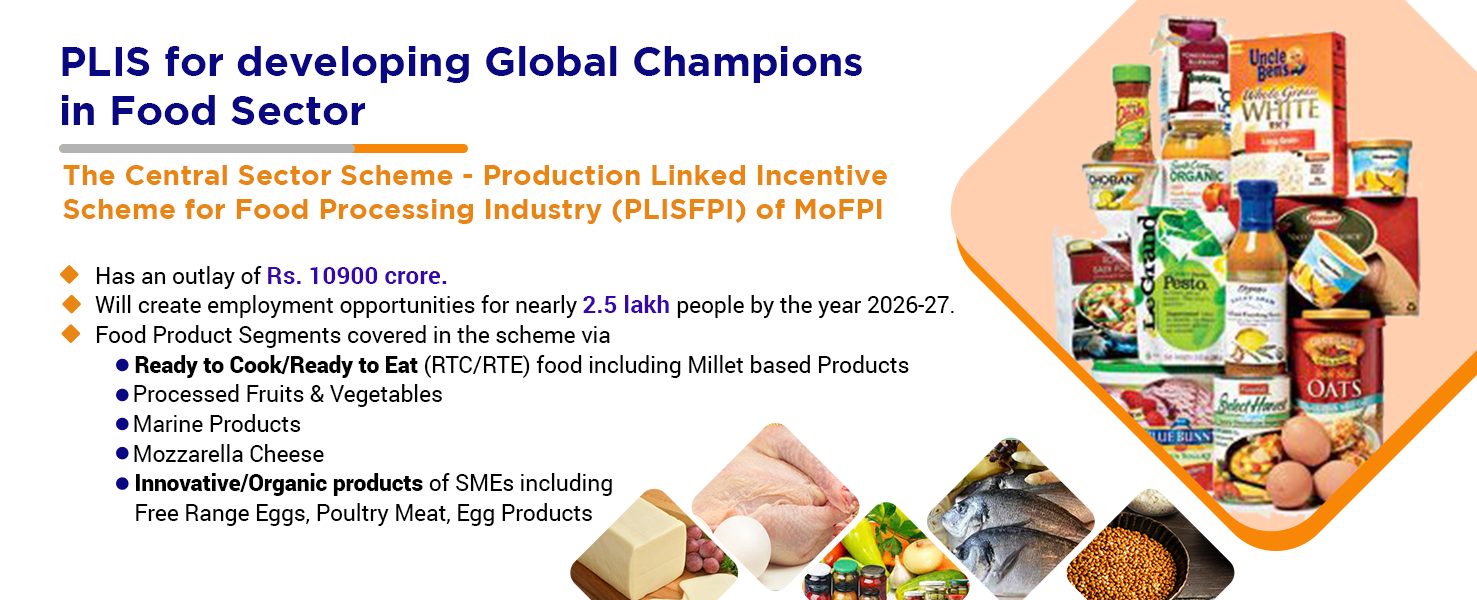
- Production-linked incentive (PLI) scheme for the food processing sector
-
-
- The Government announced this scheme on 02.05.2021 for implementation during 2021-22 to 2026-27 with an outlay of 10,900 crore Rupees.
- This will help create 2.5 lakh jobs by 2026-27, boost exports and facilitate the expansion of food processing capacity to generate processed food output worth Rs 33,494 crore.
- The effort is to take the country’s food processing to a next level amid the rising global demand for Indian ready-to-eat foods, organic products, processed fruits, and vegetables, marine products
- The objectives of the scheme are to support food manufacturing entities with stipulated minimum sales and that are willing to make a minimum stipulated investment for the expansion of processing capacity and branding abroad to incentivize the emergence of strong Indian brands
-
The shortcomings associated with Government schemes are:
-
-
- Lack of adequate infrastructure: Though the government has initiated various measures for the development of the food processing industry-related infrastructure, they are not sufficient to meet the growing needs of the sector
- Credit facilities: Despite the creation of the Food Processing Fund over a couple of years ago, the sector has been facing a resource crunch. Though foreign investment has picked up now, it still doesn’t match the requirements of the industry
- Lack of comprehensive policy: The food processing industry is a sunrise sector. The lack of a comprehensive policy addressing the various needs of the food processing industry is obstructing its growth
-
Suggestive Road map ahead for Food Processing in India
- Storage capacities and infrastructure should be increased adequately.
- Develop good agricultural practices which lead to the transition from staple food crops to the diversification of crops. This will also create lots of job opportunities.
- Planning for robust Backward linkages to farmers. Contract farming needs to be ideally formulated and promoted with specific terms like quantity, quality, and price of products being supplied. This would shield farmers from price volatility, subject to quality commitments.
- Measures require to develop Skills at the farm level to promote best agricultural practices and also in processing activities.
- Public investment and connectivity should be increased.
- Slaughterhouse rules should be framed most comprehensively.
- Second Green Revolution should be updated with diversified technologies.
- Encouragement should be given to domestic start-ups and industry than international companies.
- There should be a Centre of Excellence between the center and the state.
- More training institutes need to be opened in all states to train upcoming entrepreneurs. Financial Grants or Scholarships should be given to the upcoming entrepreneurs.
- New technology should be updated in the training institutes and skill development should be given the top priority.
The Bottom Line
Food processing is a spectrum that ranges from basic technologies like freezing or milling, to the incorporation of additives that promote shelf stability or increase palatability. However, emphasizing unprocessed or minimally processed foods in the daily diet is optimal. But using processed foods is the preference of any consumer, and some pros and cons come with each type.
The Nutrition Facts Label and ingredients list can be useful tools to define the nutritional value of any processed food in the diet. Throughout history, foods fortified with specific nutrients have prevented deficiencies and their related health problems in certain populations. Many poor populations in the World are unable to consume enough micronutrients, which are vitamins and minerals needed to maintain general health and development. The deficiency in micronutrients may cause malnutrition. To combat this issue, governments and organizations have food fortification initiatives in place to add essential micronutrients to commonly consumed foods.
Despite challenges, Food processing in India has numerous advantages which are specific to the Indian and Global context. It can lift millions out of poverty and malnutrition. The government is trying to develop this sector in a way keeping in mind the interests of the small-scale industry along with attracting investments from big-ticket domestic and foreign players.
Also, the changing lifestyle and increasing per capita income of the Country is pushing the demand for processed goods upwards. Further due to changes in the social structure, women are now moving outside their homes for work and various other activities. This caused the adoption of ready-to-cook or eat foods by families due to time constraints in cooking foods and more convenience.
Therefore, this is the right time to invest in the Food Processing sector of India, the Sunrise Industry. This sector has tremendous scope for development. However, the growth will not remain confined to the Food Processing units only. Demand for allied industries such as food processing equipment and food logistics is also likely to rise. Once again one can see that India has huge potential to be the prominent food export hub in this post-Covid-19 era. The right interventions and robust sectoral policy certainly can make the Country a Global Leader in this segment.
Terms of Use
The contents of this website are for educational purposes and are not intended to offer personal medical or product-specific investment advice. You should seek the advice of your physician or another qualified health provider with any questions you may have regarding a medical condition. Further before deciding on investment in this sector a detailed study of the range of products and production process needs to be done to see its viability. Never disregard professional medical or any other advice or delay in seeking it because of something you have read on this website. The Nutrition Source does not recommend or endorse any products.

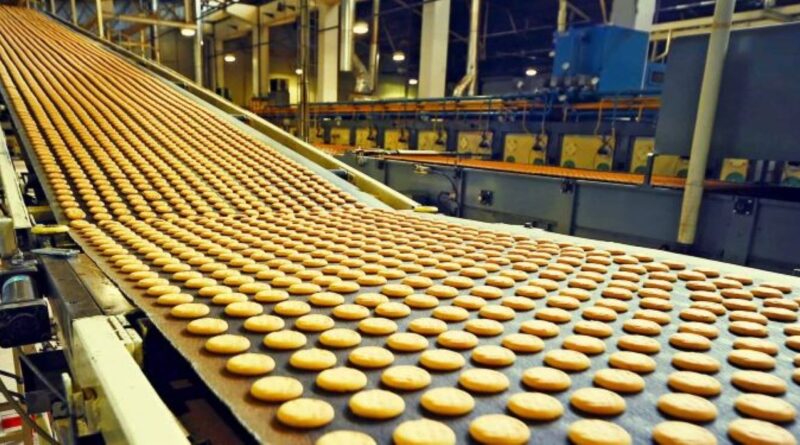

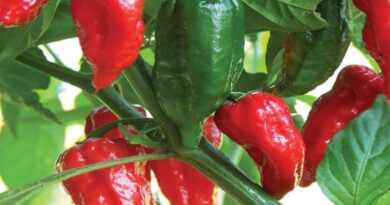

Your article helped me a lot, is there any more related content? Thanks!